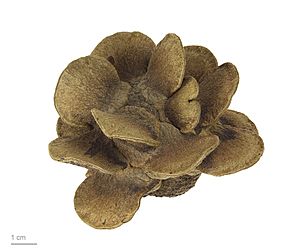Rose banksia facts for kids
Quick facts for kids Rose banksia |
|
|---|---|
 |
|
| Banksia laricina in Moore River National Park | |
| Scientific classification | |
| Genus: |
Banksia
|
| Species: |
laricina
|
The rose banksia (scientific name: Banksia laricina) is a special type of shrub that only grows in the southwestern part of Western Australia. It has many narrow leaves that are packed closely together. Its flowers are a lovely golden-brown with a bright yellow part called a style. After the flowers, it grows interesting egg-shaped seed pods called follicles.
Contents
About the Rose Banksia
The rose banksia is a shrub that usually grows up to about 1.7 meters (about 5.5 feet) tall. Unlike some other plants, it does not grow a special woody lump underground called a lignotuber that helps it regrow after a fire.
Its leaves are long and thin, like needles. They are about 5 to 15 millimeters long (less than an inch) and less than 1 millimeter wide. Each leaf has a short stem called a petiole and a sharp point at the end.
Flowers and Seeds
The flowers of the rose banksia grow in a cluster called a head, which is about 15 to 25 millimeters long. At the bottom of the flower head, there are small leaf-like parts called involucral bracts.
The flowers themselves are pale yellow, and they have a bright yellow part called a style. The flower's outer parts, known as the perianth, are about 17 to 19 millimeters long. The pistil, which is the female part of the flower, is hooked and about 27 to 30 millimeters long.
Rose banksias usually bloom from April to July. After the flowers fade, they form large, egg-shaped seed pods called follicles. These pods are quite noticeable, measuring about 22 to 30 millimeters long, 19 to 27 millimeters high, and 14 to 18 millimeters wide. The old flowers fall off as the seed pods grow.
How the Rose Banksia Got Its Name
The rose banksia was first officially described in 1964 by a botanist from Western Australia named Charles Gardner. He wrote about it in a scientific journal after collecting samples in 1958.
The second part of its scientific name, laricina, comes from a Latin word that means "larch-like." This refers to how its leaves look similar to those of a larch tree.
Scientists have studied the rose banksia to understand its family tree. In 1981, another botanist named George placed this species into a group called Abietinae. Later, in 1996, scientists Kevin Thiele and Pauline Ladiges used a method called cladistic analysis to figure out its closest relatives. They thought the rose banksia was most closely related to Banksia incana and Banksia tricuspis.
Where the Rose Banksia Lives
The rose banksia only grows in a small area in Western Australia. You can find it near the Moore River and a place called Regans Ford. It typically grows in low woodlands, which are areas with scattered trees and shrubs.
Is the Rose Banksia in Danger?
Good news! The Western Australian Government's Department of Parks and Wildlife says that the rose banksia is "not threatened." This means it's not currently at risk of disappearing.
Growing Rose Banksia at Home
The rose banksia is not often grown in gardens, but it can be. It grows best in sandy soil that drains water well and in a sunny spot. During dry summer months, it might need extra water. It can take some time, up to 18 months, for the plant to get well-established after planting.
If you want to grow it from seeds, you don't need to do anything special to them. The seeds usually sprout in about 19 to 51 days.
- Taylor, Anne; Hopper, Stephen (1988). The Banksia Atlas (Australian Flora and Fauna Series Number 8). Canberra: Australian Government Publishing Service. ISBN 0-644-07124-9.


